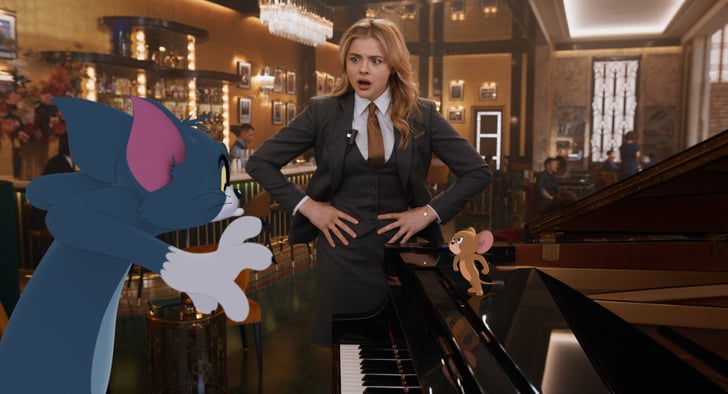Be thankful for small favors. 2021’s reimagining of Tom and Jerry does not reimagine the famous cartoon cat-and-mouse duo as photorealistic CGI charaters. Though the movie isn’t fully animated, it avoids the uncanny valley of the Alvin & the Chipmunks movies or Tim Hill’s Garfield. Instead, it portrays a live-action New York City where they and other animals are rendered as 2D cartoons. This is a path less traveled for adapting classic cartoons, replicating the success of Robert Zemeckis’ Who Framed Roger Rabbit. Tom and Jerry does what Space Jam and Looney Tunes: Back in Action did instead: take the Roger Rabbit framework and pack a ton of jokes, references, and mayhem typical to the classic cartoons it’s based on, turning it into a self-referential hybrid of live action and animation. Visually, the film looks great, with the cat and mouse letting cartoon slapstick loose in our world. Other iterations of the cartoons in film have committed to the cardinal sin of letting these silent characters talk: here, their team-up makes sense even if it’s silent, and their slapstick violence embraces the classic cartoon.
/cdn.vox-cdn.com/uploads/chorus_image/image/68881245/TJ3.0.jpg)
The film opens on Tom and Jerry trying to make new starts in the city. The pair cross paths in a park, where Jerry tries to crash Tom’s street performance, establishing their antagonistic relationship. The ensuing hijinks lead to innocent bystander Kayla (Chloë Grace Moretz) losing her job. The majority of the subsequent action is set within a swanky hotel where Kayla fibs her way into getting hired for a job for which she is not quite qualified as it staffs up in anticipation of the upcoming wedding of Ben (Colin Jost) and Preeta (Pallavi Sharda). Though Kayla charms the hotel manager, Mr. Dubois (Rob Delaney) to get the position, assistant manager Terrence (Michael Peña) dislikes her from the start. The human storyline only partly delivers. It’s hard to figure out what character you have to root for because it doesn’t give the audience enough to understand their motivations or who exactly is “good” or “bad.” Moretz’s Kayla is a particular problem here – not only does she take a lot of screen time away from the “main” characters, but she is a one-dimensional protagonist who cares about her image over the happiness and success of others and throws a fit when things don’t go her way, making it difficult to sympathize with her. That said, Jost, utilizing his SNL experience to his advantage by playing a dumb groom who wants to “go big” and impress his future wife’s family, and Ken Jeong, who plays an irritable Chinese chef, are among the highlights. Instead of focusing on the cat and mouse, a lot of the movie focuses on Kayla trying to catch Jerry (who has been living in the hotel) before the wedding, enlisting Tom to help because of their rivalry. These moments don’t drag the film, but they don’t really land the message about the difficulty of being a young adult in the job market in the current economy, either.

Ultimately, though, the problem isn’t any one actor so much as Tom and Jerry’s approach to this material. The Looney Tunes used their big Hollywood productions (as well as any attendant budgetary shortcomings) to make fun of themselves. They seem merrily aware of their own futility as movies that must follow both classic source material and Who Framed Roger Rabbit. In this way, they’re true to the spirit of the original cartoons, which were full of fourth-wall breaks, asides, and jokes about their own jokes. This tone would have supplemented Tom and Jerry, but director Tim Story goes too far in the other direction, cramming in incoherent third-act lessons about honesty and ambition, which will be about as interesting to kids as the fate of Colin Jost’s expensive wedding. The movie may look like one of those clever, ill-fated Roger Rabbit descendants, but it clearly wants to remain palatable to fans of Alvin & the Chipmunks-style grotesquerie, where classic characters are re-rendered as expensive special effects around which actors can debase themselves.
“Tom and Jerry” resists the temptation to redesign its title characters, although they get some subtle tweaks. The team at Warner Animation Group has eliminated the thick black lines that make them look “cartoony,” and added shading here and there to give them a bit of dimension. But they remain the Tom and Jerry we’ve always known, right down to the decision to keep them silent. They still raise a ruckus, of course, but they don’t speak, relying on pantomime and sight gags to communicate. It does feel as if the filmmakers may have been pressured to have Tom and Jerry make up in the end, but rest assured – if the movie does well enough, they’ll be back at each other’s throats in no time.
3/5 STARS
